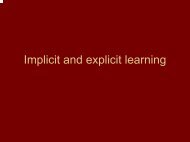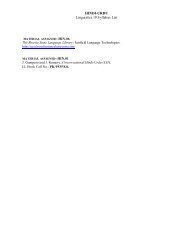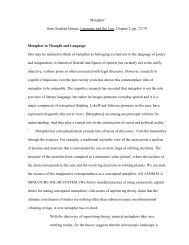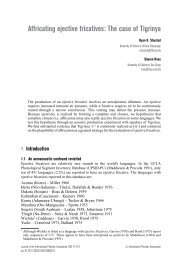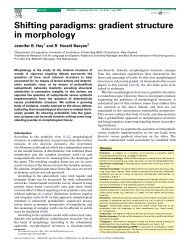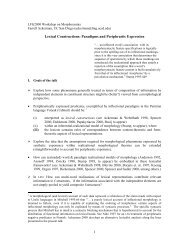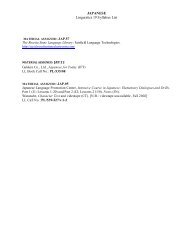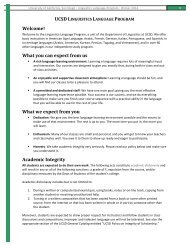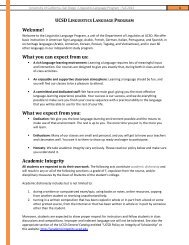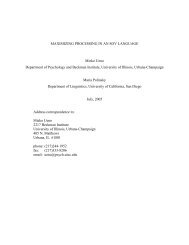The morphological structure of the Moro verb Sharon Rose
The morphological structure of the Moro verb Sharon Rose
The morphological structure of the Moro verb Sharon Rose
You also want an ePaper? Increase the reach of your titles
YUMPU automatically turns print PDFs into web optimized ePapers that Google loves.
<strong>The</strong> <strong>morphological</strong> <strong>structure</strong> <strong>of</strong> <strong>the</strong> <strong>Moro</strong> <strong>verb</strong><br />
<strong>The</strong> proximal imperative is formed from <strong>the</strong> <strong>verb</strong> root and a final suffix -ó.<br />
All tone-bearing units in <strong>the</strong> proximal imperative <strong>verb</strong> stem bear high tone,<br />
which is marked with an acute accent (´). Low tone is unmarked. <strong>Moro</strong> has a<br />
two tone system, High (H) and Low (L). Jenks & <strong>Rose</strong> (2011) analyze it as a<br />
H vs. Ø system, where Ø is unmarked.<br />
(2) a. və́léð-ó pull! h. ábə́ɾ-ó fly!<br />
b. tə́ŋát ̪-ó lick! i. ódə́ɲ-ó squat!<br />
c. pə́ɡə́ð-ó pay! j. ámádát ̪-ó help!<br />
d. ʧómbə́ð-ó tickle! k. érl-ó walk!<br />
e. váð-ó shave! l. áɾ-ó cry!<br />
f. ɡə́ɲ-ó kill! m. áfː-ó build, shoot!<br />
g. lánd̪-ó close! n. óg-ó thresh!<br />
Verb roots with high vowels i ʌ u and some ə, cause <strong>the</strong> final suffix -ó to be<br />
realized as raised ú. This is part <strong>of</strong> <strong>the</strong> general vowel harmony system in<br />
<strong>Moro</strong>, whereby <strong>the</strong> higher vowels i ʌ u trigger raising <strong>of</strong> <strong>the</strong> lower vowels e a<br />
o to i ʌ u. <strong>The</strong> vowel ə participates in both types <strong>of</strong> harmony patterns, as seen<br />
by a comparison <strong>of</strong> (2c) and (3b).<br />
(3) a. mə́ɲʌ́ʧ-ú peel, remove layer! h. ʌ́wút ̪-ú throw!<br />
b. rə́gəń-ú work! i. ílíð-ú buy!<br />
c. wúndə́t ̪-ú wring! j. ʌ́ŋʌ́ʧ-ú show!<br />
d. sʌ́ð-ú defecate! k. ʌńdúð-ú bite!<br />
e. kíð-ú open! l. úrtə́ð-ú pull out!<br />
f. t̪únd̪-ú cough! m. íð-ú make!<br />
g. də́ɾ-ú wrap, cover! n. ʌ́ɡ-ú put!<br />
<strong>The</strong> distal imperative is formed from <strong>the</strong> <strong>verb</strong> root and <strong>the</strong> suffix -a. This<br />
vowel is raised to ʌ when attached to roots with high vowels. <strong>The</strong> entire <strong>verb</strong><br />
form is low-toned 3 .<br />
(4) a. vəleð-a pull! i. abəɾ w -a fly!<br />
b. pəɡəð-a pay! j. amadat ̪-a help!<br />
c. vað-a shave! k. aɾ-a cry!<br />
d. ɡəɲ-a kill! l. afː-a build, shoot!<br />
e. məɲʌʧ-ʌ peel, remove layer! m. ʌwut ̯-ʌ throw!<br />
f. rəgən-ʌ work! n. ilið-ʌ buy!<br />
g. sʌð-ʌ defecate! o. ʌnduð-ʌ bite!<br />
h. dəɾ-ʌ wrap, cover! p. ʌɡ-ʌ put!<br />
3 When followed by a noun phrase, or an object marker, <strong>the</strong> final suffix<br />
vowel carries high tone.<br />
3



